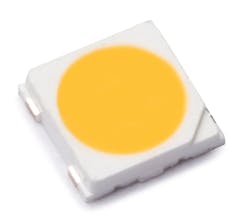Lumileds documents long-life mid-power LED components
Luxeon 3535L mid-power LEDs are projected to deliver L90 performance of 60,000 hours when operated at 85°C and driven at 200 mA.
Lumileds has announced the results of LM-80 testing and TM-21 projections on Luxeon 3535L mid-power, packaged LEDs that the company said implies component lifetime that exceeds the requirement of all market-transformation-program requirements for solid-state lighting (SSL) luminaires. The company believes the test results prove the mid-power devices capable of serving reliably in demanding applications such as downlights, high-bay fixtures, and troffers as well as in retrofit lamps including LED-based T8 tubes.
IES (Illuminating Engineering Society) LM-80 is the standardized methodology through which LED manufacturers characterize LED performance and lifetime based on actual testing of packaged LEDs at specific temperature levels. IES TM-21 allows a manufacturer that accrues 6000 or more hours of LM-80 test data to further predict component lifetime based on standardized calculations.
Lumileds isn’t publicly revealing the test data set, although the company will provide that data to potential customers. But the company did release highlight numbers. LM-80 tests were conducted separately at 55°C, 85°C, and 105°C junction temperatures. TM-21 projections yield an L90 (the lifetime to 90% of initial lumen output) figure of 60,000 hours for LEDs operated at 85°C and driven at 200 mA. Lumileds suggest that the lifetime would enable 13 years of life for a luminaire operated 12 hours each and every day.
At least one manufacturer using the mid-power LEDs commented on the record about the data. "The reliability of the Lumileds Luxeon 3535L gives me confidence to rate my products with long lifetimes," said Brian Hennessey, president and CEO of Titan LED — a manufacturer of LED tubes. "Titan LED’s customers appreciate our quality, which is why we choose Lumileds LEDs."
The lifetime data enables Lumileds to state that the mid-power LEDs can be deployed in products that require certification to market-transformation programs such as Energy Star from the US Environmental Protection Agency and the DesignLights Consortium. Such organizations set minimum lifetime levels and are often necessary certifications for lamps or luminaires to qualify for rebates and other energy-efficiency incentives.
High-power-focused LED manufacturers such as Cree have consistently questioned the longevity of mid-power LEDs as documented in a feature article from last year. The Lumileds tests would indicate that mid-power LEDs in plastic packages can offer more than acceptable reliability. Of course, high-power LEDs can operate at even higher temperatures, enabling higher drive current and thereby minimizing the number of LEDs required in a product. Lumileds also did not address color maintenance in the announcement on the LM-80 data.
We asked Lumileds if the 3535L used a package design that was enhanced for longer life. For example, some companies are using epoxy-molded-compound (EMC) packages with mid-power LEDs to increase lifetime, especially for LEDs operated at high temperatures. The company said the package is a composite inorganic-thermoplastic package.
"Based on our experience as a leading high-power LED manufacturer, we were able to utilize our technology know-how to create the Luxeon 3535L, which has become a top choice among discerning LED lighting manufacturers," said Rahul Bammi, vice president of product management and marketing.

Maury Wright | Editor in Chief
Maury Wright is an electronics engineer turned technology journalist, who has focused specifically on the LED & Lighting industry for the past decade. Wright first wrote for LEDs Magazine as a contractor in 2010, and took over as Editor-in-Chief in 2012. He has broad experience in technology areas ranging from microprocessors to digital media to wireless networks that he gained over 30 years in the trade press. Wright has experience running global editorial operations, such as during his tenure as worldwide editorial director of EDN Magazine, and has been instrumental in launching publication websites going back to the earliest days of the Internet. Wright has won numerous industry awards, including multiple ASBPE national awards for B2B journalism excellence, and has received finalist recognition for LEDs Magazine in the FOLIO Eddie Awards. He received a BS in electrical engineering from Auburn University.





